Tour
True to the Turbines' name, the back of the ear buds do, indeed, look like a pair of turbines. Towards the front of the ear buds have blue and red rings, which signify the left and right channels respectively.
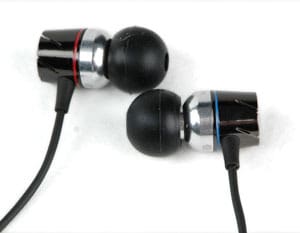
Beyond that, the ear buds have a metallic finish and the nozzles are topped with a metal mesh.
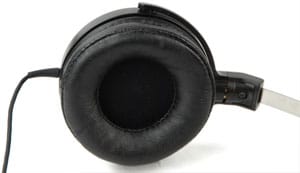
The two ear buds merge at a robust neck split.

After the neck split, the Turbines finish off at a standard 1/8-inch plug.

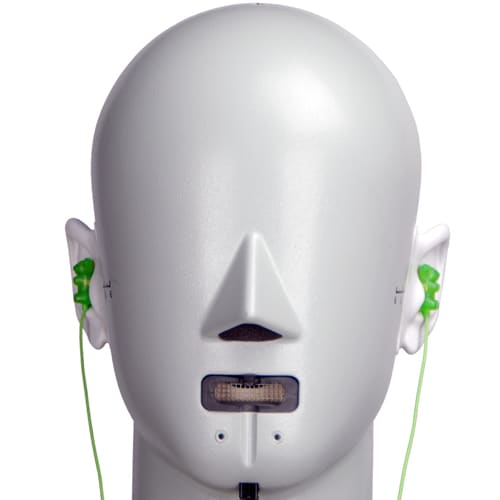
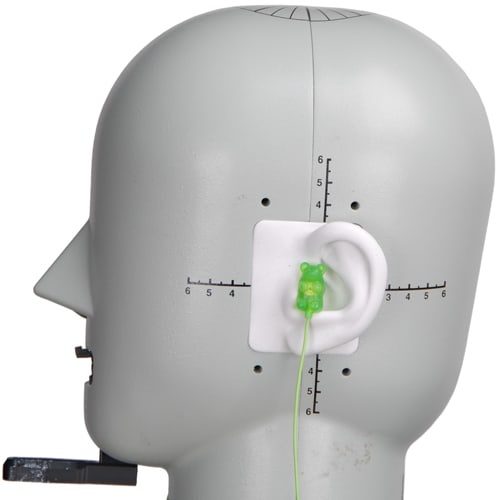
In the Box
{{section_header}}{{section.name}}{{/section_header}}
The Turbines come with a pouch, two sizes of triple-flanged sleeves, and three sizes of soft plastic sleeves.
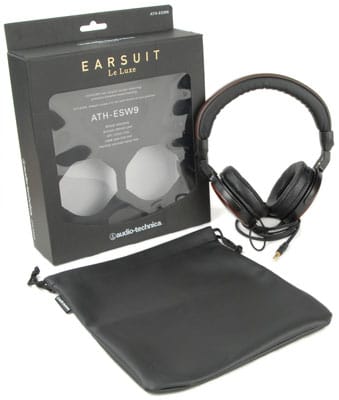
Durability
{{section_header}}{{section.name}}{{/section_header}}
The Monster Turbines have one main seem robust, except for one area: cord guards. Cord guards are the semi-rigid bits of rubber that are located at points where the cable runs into a hard plastic surface. The cord guards serve to stop the cable from bending too sharply at that hard edge, which exacerbates wear and tear. Note that the Turbines only have cord guards after their ear buds, but don't have any at the neck split or plug.
The lack of a cord guard at the plug is especially dangerous, since it'll stick straight out of your device. As we saw on the MM 50 iPs, this could cause issues if you're connecting to a media player in your pocket. Whenever the media player moves around, the top of the plug will be rubbing against the sides of your pocket, pulling on the cable. Taking the media player out of your pocket will also pull at this junction, since you likely have some cord tucked into your pocket that will catch on the fabric and create resistence. Bad cord guards are the #1 killer of in-ear headphones.
Other areas of the Turbines seem durable. The ear buds are solid, the nozzles are thick and stout (unlikely to snap off), and the cable is about as thick as you'll see on a set of in-ears.
Aesthetics
{{section_header}}{{section.name}}{{/section_header}}
The Turbines are a set of nice-looking in-ears. The 'turbine' design is attractive, as is the glossy black plastic towards each ear buds' back end. In-ears don't have a lot of surface area to design for, but Monster has done a good job with what was available.
Summary
{{section_header}}{{section.name}}{{/section_header}}

The Monster Turbines are a set of in-ears from the popular cabling company. The Turbines feature an interesting design, which is hard to pull off on such a small piece of plastic. We thought that the Turbines were comfortable, but they tended to come loose very easily. Also, since there isn't a cord guard at the plug, if you're planning to use the Turbines with a media player in your pocket, you should tape up the end of the end of the plug to stave off premature wear and tear.
Frequency Response
{{section_header}}{{section.name}}{{/section_header}}
The Turbines did well here for the most part. They emphasize bass like crazy, and therefore might sound a bit boomy to some. Fortunately, they reel it back a bit and fall within the limits until just before the 10kHz mark. At this point the right channel takes a 10dB drop for a short stretch. This means that any instrument using this frequency will likely sound a bit dull, more so in the right ear than the left. After the scoring limit ends, the graph generally trends downwards, meaning the brilliance of some instruments might be a bit understated.
Other than the downward spike near 10kHz, the Turbines did well on this test. Fans of booming bass should pay particular attention to these things.

The Turbines had the best frequency response out of all our comparison headphones. Typically in-ears don't do well on this test compared to full-size headphones. There are many reasons why this is the case, including tiny drivers and being particularly finicky with regards to positioning – all we know is there's a trend towards poor frequency response. The Turbines prove to be an exception to the rule, with a score that's better than most on-ear or over-ear headphones. The only comparison headphones below that came close to the Turbines were the MM 50 iPs, which are currently our highest rated in-ear headphones.
Distortion
{{section_header}}{{section.name}}{{/section_header}}
The Turbines had okay distortion control. Throughout, the levels of distortion never rose far above 1%, and mainly stayed below 0.5%. If you listen to a lot of vocals, you might notice something a bit funny on a track you know particularly well. Differences would also be apparent if you switched between these headphones and headphones with lower distortion. The average consumer might not notice the difference, but chances are, if you're actually reading this section, you aren't the average consumer.
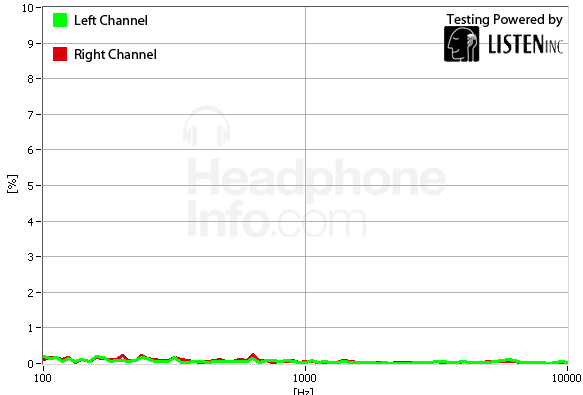
Unlike frequency response, there's no real trend towards high or low levels of distortion on in-ear headphones. As you can see from the chart below, the range is quite large.
In a group of its peers, the Turbines fall on the below average side, and not just because the two Sennheiser in-ears received outstanding scores. The current average score for this section is a bit over 5, so while the Turbines didn't perform horribly, they could do with some improvement.
Tracking
{{section_header}}{{section.name}}{{/section_header}}
The Turbines didn't do a bad job here. The right channel seems to be slightly louder than the left during the low and middle frequencies, with the left channel growing louder a little before the 1000Hz mark. These skews towards the left and right channels are slight, however, staying within a 4dB range. The sudden hump just after 100Hz is the sharpest incline and decline up until 10kHz, and it's not a particularly big swing.
Towards the 10kHz mark the graph goes a bit funny, but that's normal and not particularly accurate. Really, the most significant bump here is after 100Hz. While it moseys a little afterwards, the changes aren't particularly sudden or stark.
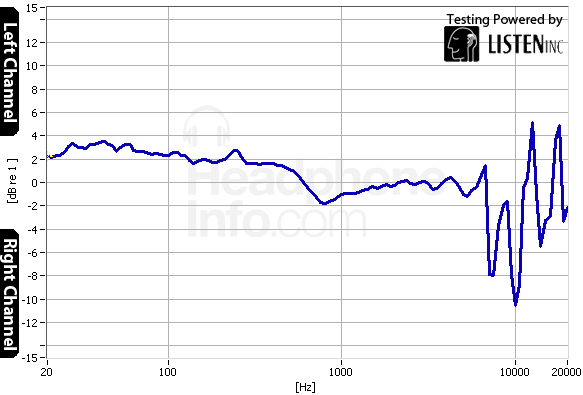
The Turbines' peers had slightly better tracking on average. Note how flat their lines are in comparison. The only one with a similar jump is the AH-C351s, but it was a bit smaller. Despite only beating the V-MODAs on the list of headphones below, the average score for this section is a bit under 7, so the Turbines are still slightly over average. Unless you're particular about your headphones, the Turbines' tracking won't bother you.
Maximum Usable Volume
{{section_header}}{{section.name}}{{/section_header}}
The Turbines were capable of outputting 118.87 decibels, which is a good amount. We award max points for 120dB: anything over that is downright harmful, regardless of how distortion-free it is. This is actually a bit quieter than many in-ear headphones, which typically output over 120dB, but a difference of one decibel and change isn't a particularly large gap.
Isolation
{{section_header}}{{section.name}}{{/section_header}}
The Turbines do an ok job of isolating for a pair of in-ears. Like all other in-ears, they do a great job above 1kHz and a significantly less great job below it.
In-ear headphones, which are essentially ear plugs, have a tendency to isolate better than all other headphones, including those with active noise cancellation. This being said, active noise cancelling headphones excel at blocking out low-end noise. Active cancellers also block out far less middle or high frequency noise and block out less noise overall.

In-ears have the potential to block out a lot more noise than the Turbines did, but they still didn't compare badly to their peers. The only headphones that blocked out significantly more noise were the SE420s and their foam ear buds (if the sleeve looks like an actual ear plug, chances are it'll perform like an actual ear plug). The Turbines ended up coming out on the top half of the comparison headphones below, but just barely. Compared to all headphones, the Turbines are way above average, but compared to other in-ears, they had solidly average isolation.
Leakage
{{section_header}}{{section.name}}{{/section_header}}
The Turbines performed well enough here, although they were below average for a set of in-ears. Typically in-ears score closer to our max score of 10. Chances are the Turbines would be fine to listen to at a moderate level in just about any public setting, although if you're in a silent library those around you7 might hear a whisper of your music. If you listen at a louder level, you'll only annoy everyone further.
Short-Term Use
{{section_header}}{{section.name}}{{/section_header}}
The Monster Turbines were of average comfort for a set of in-ears, but had one fatal flaw: they pop out of place ridiculously easily. If you accidentally tug them, they'll come loose. If you twist your head too far, they'll come loose. These are not good jogging headphones.
Extended Use
{{section_header}}{{section.name}}{{/section_header}}
Even just sitting, not moving, the Turbines will gradually fall out of place over the course of a few hours. We weren't particularly annoyed by this because the ear buds only popped out of place a few times over the course of a 6-hour listening session, but the fact that they came out at all when we were sitting stock still was surprising.
Cable Connectivity
{{section_header}}{{section.name}}{{/section_header}}
The Turbines have a cable measuring 3 feet, 9 inches (1.14 meters). This is an average length for a set of in-ears. Also typical is the absence of any adapters. The cord is very thin, however, which means all you first-generation iPhone users (or any other device with a recessed headphone jack) are all set.
Customizability
{{section_header}}{{section.name}}{{/section_header}}
The Turbines come with small, medium, and large soft plastic sleeves and two sizes of triple-flanged sleeves. This should help you find the fit and style that you like, but the selection is a bit sparse for $150 headphones. Compare the Turbines' customization options to the Shure SE420s, which come with three sleeve types and also an optional in-line volume dial.
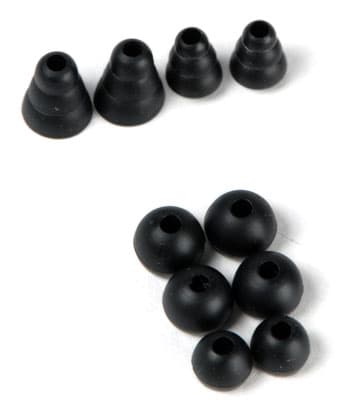
Portability
{{section_header}}{{section.name}}{{/section_header}}
In-ear headphones are just about as portable as a set of wired headphones can get. The Turbines don't have a super short cord, meaning there are a few more portable options for those that keep media players in arm bands or a lapel pocket. Many users will probably prefer the Turbines' cord length, however.
The Turbines do come with a pouch, but it isn't a particularly good one. It looks a lot like a change purse, with open sides that are held together with an elastic strip of fabric. This means the pouch is really only good for holding the headphones, because if it turns upside-down all the sleeves would spill out. The ear buds typically stay on the Turbines, so we're not particularly worried about those falling out, but it remains a possibility. The pouch also has no means of managing the cord, meaning you'll have to ball the Turbines up and shove them in. Pouches that are simply pouches are nice because they're free, but for the most part they're useless. If you keep the headphones in the pouch, it just means you'll have to carry around an empty pouch while the headphones are in use, and the pouch itself takes up more pocket space than the headphones alone would.
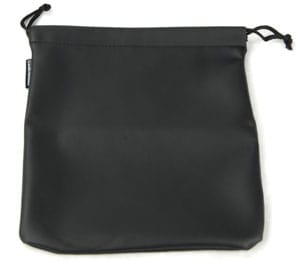
Maintenance
{{section_header}}{{section.name}}{{/section_header}}
Like most in-ear headphones, the Turbines can't be taken apart to any extent to fix or modify them. You can remove the sleeves to help clean them without getting any internal components soggy. Some in-ears come with cleaning tools or removable wax guards to protect the nozzles, but the Turbines do not.
Other Features
{{section_header}}{{section.name}}{{/section_header}}
Battery
The Turbines do not requires a battery, netting them some points. Batteries are annoying, often die at inopportune times, and either require recharging or a repeated additional investment.
Value
{{section_header}}{{section.name}}{{/section_header}}
Monster has a reputation for slinging overly expensive products. The Turbines serve to single-handedly shatter this popular belief, because they cost only slightly more than they should. If you're looking for a set of in-ears in this price range, there are slightly better headphones out there, like the Etymotic 6isolators or Sennheiser CX 95s, but the Turbines have most of them beat in terms of style.
Conclusion
{{section_header}}{{section.name}}{{/section_header}}
The Monster Turbines have the unfortunate position of being better than average at a price point full of excellent headphones. They received good scores and aren't too overpriced, but then again we really couldn't recommend them over all the other, better options around this price point. If you really like the way they look, or have already bought them, then don't fret: they aren't bad. They simply aren't as great as some of the other headphones you could've bought for a bit less money.
Meet the tester
Mark Brezinski works on the Home Team, reviewing refrigerators, minifridges, dishwashers, washing machines, dryers, air conditioners, air purifiers, and fans.
Checking our work.
Our team is here for one purpose: to help you buy the best stuff and love what you own. Our writers, editors, and lab technicians obsess over the products we cover to make sure you're confident and satisfied. Have a different opinion about something we recommend? Email us and we'll compare notes.
Shoot us an email
